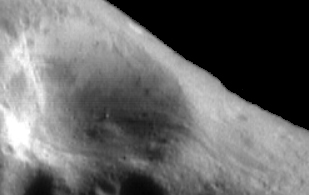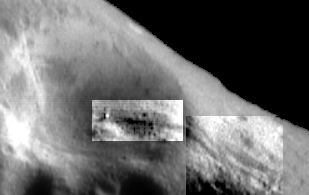The NEAR Challenge Results
Tom Van Flandern [Reprinted from the Meta Research Bulletin 00/06/15]
The NEAR spacecraft went into orbit around asteroid Eros on February 14, 2000. Most of you will be aware of our NEAR challenge, based on the exploded planet hypothesis. We predicted that the orbiting spacecraft would find at least three currently orbiting moons, or (if the gravity field is unstable) at least three former moons resting on the surface after a grazing touch-down from a slowly decaying orbit. The latter, we indicated, would be uniquely recognizable as former moons by roll marks that would result from the 10 m/s horizontal velocity of a former moon at the point of first touch-down. Friction is minimal in such a weak gravity field, so rolling boulders should leave long, tell-tale linear tracks on the surface.
The gravity field did turn out to be mostly unstable. However, the very first image of Eros from orbit, reproduced on the next page and available on our web site, seems to show a linear track starting randomly on the asteroid’s surface, then climbing up the outside wall of a crater, running down the inside wall, ending at a 50-meter boulder near the crater center. Many people have commented that this looks remarkably like what we predicted in the June 15, 1999 issue of MRBand illustrated by Starosta’s cover artwork on that issue. Since that initial picture, dozens of additional trails, boulders, and trails ending in boulders have been found on the surface of Eros. Surprised planetary astronomers are now theorizing about boulders ejected from the interior of Eros during collision events. But this ignores that the exploded planet hypothesis, a model with a close-to-perfect record of successful predictions, also predicted this phenomenon in advance of discovery. It also ignores that trails without craters at their beginning, and going uphill from there, imply considerable horizontal momentum for the boulders that made them. That can only be true if they came from orbit. In view of these findings, we declare the “NEAR challenge” won. However, what speaks even louder than another successful prediction for the eph is that no astronomer accepted our NEAR challenge despite it being widely publicized.

NEAR photo of a large crater on Eros with a trail across a crater rim, leading to an interior boulder

Same as left, with portions of the trail and boulder contrast-enhanced for easier visibility.
To his considerable credit, planetary astronomer Andrew Cheng, the spokesperson for the NEAR team (operating from the Applied Physics Laboratory instead of the Jet Propulsion Laboratory for a change), presented evidence that Eros originated from “probably a planet-sized body that once broke up”. Under questioning at a NASA press conference, Cheng explained that little is known to constrain the parent body size, but that the current opinion of most astronomers is that it was Moon-sized or smaller. This evidence for a large parent body for Eros includes:
To his considerable credit, planetary astronomer Andrew Cheng, the spokesperson for the NEAR team (operating from the Applied Physics Laboratory instead of the Jet Propulsion Laboratory for a change), presented evidence that Eros originated from “probably a planet-sized body that once broke up”. Under questioning at a NASA press conference, Cheng explained that little is known to constrain the parent body size, but that the current opinion of most astronomers is that it was Moon-sized or smaller. This evidence for a large parent body for Eros includes:
geological layering, which could not have been created directly on the asteroid because its escape velocity is so low, and material from any impact big enough to create layers would therefore escape.
diversity of composition, showing major spectral differences over the surface, and even within single craters.
evidence of chemical differentiation, which implies near-total melting sometime in the past with consequent separation of heavy and light elements by gravitational sorting – things usually associated with planets
solidness implied by the density, as contrasted with the sort of rubble pile expected for an object formed by repeated impacts.
Slowly, gradually, a recognition of the eph as a necessary ingredient to explain solar system history and evolution is getting around. Even the UPI coverage of the NASA press conference was kind enough to mention our prediction.
EPH Articles
- 2007 Aurigids Meteor Outburst
- A Revision of the Exploded Planet Hypothesis
- Absolute GPS to better than one meter
- Absolute GPS to better than one meter - Page 2
- Absolute GPS to better than one meter - Page 3
- Absolute GPS to better than one meter - Page 4
- Asteroidal Satellites and the "Exploded Planet Hypothesis"
- Coming Perseid Meteor Storms
- Deep Impact Findings - 1
- Deep Impact Findings - 2
- Deep Impact: Coming clues to the Origin of the Solar System
- Introduction
- Leonid Meteors Predictions
- Origin of Trans-Neptunian Asteroids
- Perseid Meteor Storms
- Planetary Explosion Mechanisms
- Predictions for the Major 2001 Leonid Meteor Storm
- Satellites of Comet Hale-Bopp (update)
- Solar System Archives
- Status of 'The NEAR Challenge' (2 class="before-icon"
- Status of 'The NEAR Challenge' (21 March, 1999)
- The Exploded Planet Hypothesis
- The Exploded Planet Hypothesis 2000
- The NEAR Challenge
- The NEAR Challenge -- Results
- The NEAR Challenge Overview
- The NEAR Challenge Update
- The Original Solar System
- The Tale of Two Asteroids
